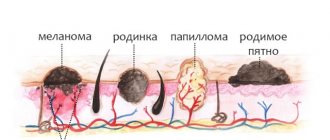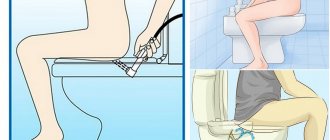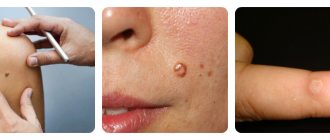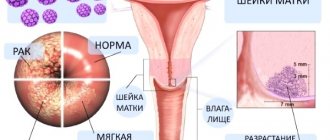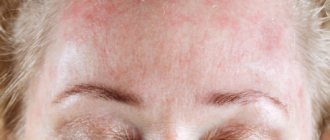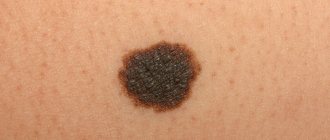Papillomas on the butt appear as a result of infection with HPV (human papillomavirus). The formations are benign and appear not only on the skin of the buttocks, but also in the perianal area (on and around the anus). Papillomavirus provokes tissue proliferation because it affects cell activity. Most types of HPV are harmless, but some types have a high cancer risk. Therefore, if you find small growths or warts on the buttocks or in the anal area, you should immediately visit a dermatovenerologist.
Causes of anal papilloma
According to statistics, about eighty percent of the world's inhabitants are carriers of HPV (human papillomavirus). Most of them may not be aware that they are infected. This is due to the “dormant” phase of the papillomavirus. During this period, HPV does not manifest itself in any way. The activation of papillomavirus and the development of papillomatosis is promoted by:
- Decreased immunity due to acute viral or bacterial infection;
- Physical or emotional stress;
- Hormonal changes in teenagers, pregnant women or nursing mothers;
- undergoing chemotherapy;
- Long-term use of antibiotics or steroids;
- Using hormonal contraceptives or IUDs;
- Exacerbation of chronic gastrointestinal diseases.
Locations of growths in the anus
Anal papillomas are considered a disease of the anus of viral etiology. Formations in the intimate area can number from several to several hundred. Anal growths are flesh-colored papillae, consisting of lobules and stalks.
First, small spots and growths form in the perianal area, which increase in diameter over time and under favorable conditions for growth.
As a rule, these formations do not cause pain. That is why a person may not even suspect that there is a problem for a long time.
Then the affected area may increase sharply. Warts begin to actively grow and multiply. Over time, growths can already be found directly in the anus and outside of it. In advanced cases, the mucous membranes of the large intestine are affected.
Classification of papillomas on the butt
Genital warts or papillomas that form around the anus are classified into the following subtypes:
- Single large ones;
- Multiple, merging into one formation;
- Single ones are small in size.
Very often, during a superficial examination, a papilloma and a wart are confused. A distinctive feature of papillomas is the “leg”. Thin or, in isolated cases, wide. The surface of the papilloma is scaly. The color of the formation ranges from whitish to dark brown. Localization of condylomas is the skin around the anus or the rectal mucosa. The second type often causes problems with timely bowel movements (constipation). Diagnosing such internal formations is much more difficult.
Removal of perianal condylomas at the MedicCity clinic
The most modern surgical method is the use of the SURGITRON device (the advantage is high efficiency with the formation of a minimal burn surface). The procedures can be performed in several stages.
The preferred method of pain relief is local infiltration anesthesia. A prerequisite for the operation is a histological examination of removed perianal condylomas, which is due to the risk of malignancy of this type of formation.
Our clinic offers a variety of methods for diagnosing, treating and preventing a wide range of proctological diseases. Our proctologists are specialists in their field who approach the most delicate problems with great tact and attention. We successfully treat proctitis, colitis, coccyx cysts, anal itching, irritable bowel syndrome, etc.
Hemorrhoids and anal fissures in our clinic are treated painlessly, on an outpatient basis, in 1 day, using therapeutic sleep.
You can leave your reviews about the treatment of perianal condylomas and other proctological diseases here.
Routes of infection
Penetrating into the human body, the papillomavirus settles on the lower layer of the dermis. The incubation or “dormant” period of the disease can last several months and sometimes years. At this time, HPV is located exclusively in the layers of the skin or mucous membranes. After the disease enters the active stage, a sharp growth of viral cells begins; they penetrate the DNA of dermal cells, provoking their growth and the appearance of growths. At this moment, the sick person becomes dangerous to others, as the possibility of transmitting the papillomavirus opens up.
Why is perianal papilloma transmitted?
Infection with the human papillomavirus occurs through sexual contact with an infected partner. The use of contraceptives does not provide a 100% guarantee of protection against infection.
Important!
The risk of infection is directly proportional to the duration of sexual contact with an infected partner.
HPV can enter the bloodstream through microtraumas of the skin or mucous membranes. The skin in the genital area is much thinner, so the risk of injury is much higher. Blood from a damaged tumor increases the possibility of infection spreading.
Symptoms of anal papillomatosis
The initial stage of development of the disease is accompanied by the following symptoms:
- Feeling of itching or burning around the anus;
- The occurrence of painful sensations during bowel movements, occasionally with minor bleeding;
- A feeling of swelling in the anus or a foreign body being in it;
- Constant feeling of moisture on the butt;
- Copious discharge of mucus from the anus;
- Slight increase in body temperature up to 37 degrees.
How to treat
Papillomas between the buttocks require mandatory treatment. Otherwise, the infection will progress, affecting more and more healthy tissue, which can lead to serious consequences.
Over time, these formations can lead to cancer if measures are not taken to eliminate them.
The choice of treatment method depends on the size of the formations, the degree of damage and localization.
Acceptable pharmaceutical drugs
Local medications are used to remove small anal lesions. Papilloma near the anus is treated with the selected remedy. It is important to do this carefully so as not to damage healthy skin, which may become scarred. Ointments used:
- Podophyllotoxin;
- Oxolinic;
- Bonaftone;
- Ridoxol;
- Solcoderm.
Resorcinol powder mixed in half with dermatol is applied to each element of the rash. A podophyllin solution (20%) is used to moisten each anal growth.
Strengthening the immune system
The main therapeutic direction is to stimulate the body's defenses. Antiviral and immunomodulatory drugs are prescribed that destroy small anal papillomas:
- Viferon in the form of tablets or suppositories;
- Immunomax in the form of injections;
- Lykopid (tablets);
- Genferon (anal suppositories).
An important point in the question of how to get rid of papillomas on the butt and strengthen natural defenses is diet therapy and vitamin complexes. During the treatment of papillomatosis, proper eating behavior plays a significant role.
The dietary table should contain a large amount of vegetables, fruits, and fiber. This will improve digestion, stool quality, and make defecation easier. You need to pay attention to correcting your drinking diet - drink at least 1.5 liters of water per day.
Additionally, vitamin complexes are prescribed with the obligatory content of vitamins C, A, D, B-group, which significantly increase the body's defenses.
Treatment with folk remedies
Traditional medicine can also offer many remedies for treating anal papillomas. The safest methods for treating anal growths are:
- Using fresh chicken egg white. The product must be applied to the process for several hours. After the white has dried, apply again. Repeat the procedure for several days.
- Aloe. You need to take a fresh leaf of the plant, cut it, and apply the glandular part to the anal warts. Secure with adhesive tape and leave for 4 hours. The course of treatment is up to 2 weeks.
- Lubrication with castor oil. The oil must be applied to the affected area and covered with a piece of cotton wool on top. Repeat 2 times a day.
- To remove single small anal formations on the skin of the buttocks, you can use iodine. The product is applied to the papilloma 2 times a day, and after application it is covered with a piece of cotton wool. Only damaged areas are covered with iodine: you need to avoid getting the product on healthy skin, which can burn. Iodine solution cannot be used between the buttocks or on the anus.
Before using folk remedies, be sure to consult with your doctor - self-medication can cause severe damage and contribute to malignancy.
Radical removal
Large papillomas of the anal area and internal condylomas are removed using radical techniques:
- Laser ray. The laser evaporates tumor cells layer by layer without affecting healthy tissue. In this case, the capillaries are cauterized, the procedure is completely bloodless. The rehabilitation period is up to several weeks.
- Cryodestructive method. Anal papillomas are removed by freezing with liquid nitrogen. A postoperative scar may appear at the site of the destroyed tumor. Healing – up to 2 weeks.
- Radio wave removal. The formation is destroyed using a radio knife. The technique completely eliminates the risk of secondary infection. The recovery period is up to 12 days.
- Burning out papilloma with alternating current (electrocoagulation). The healing period is up to 4 weeks.
- Surgical intervention (used for deep-rooted, extensive growths). The body of the growth along with the root is excised with a scalpel. The recovery period is up to 2.5 months.
Timely treatment of anal papillomas will relieve discomfort, pain in the delicate area, and prevent complications of papillomatosis.
Contact a specialist
Many people are interested in the question of which doctor to go to if papillomas grow on the buttocks or around the anus, and whether it is worth seeking help from a specialist at all. A proctologist deals with growths near the anus or in the rectum.
Important!
The risk of malignancy of benign formations in the anal area is very high.
This is due to constant injury to condylomas in the rectum. You can avoid the growth of a tumor into cancer only by promptly seeking qualified medical help and starting therapy.
Diagnosis of anal papillomatosis in most cases consists of examination, interviewing the patient and, if necessary, sigmoidoscopy. Such a study allows the proctologist to assess the full picture of the disease and prescribe effective treatment.
Prevention and complications
Why are papillomas localized in the rectal area dangerous? A dangerous complication is the malignancy of the process, and this is the most common consequence for growths, because in such an area there is constant friction.
Other complications of HPV include:
- bleeding due to injury to the growth;
- penetration of a secondary infection into the neoplasm;
- development of a precancerous condition.
To prevent such negative consequences and the development of human papillomavirus infection, it is recommended to focus efforts on increasing the body’s protective function. You should also adhere to a healthy lifestyle and exclude casual sexual intercourse.

